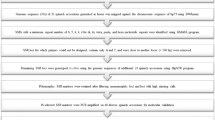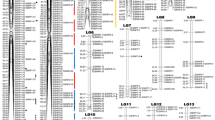Abstract
Molecular breeding in sesame is still at infancy due to limited number of microsatellite markers available and the low level of polymorphism exhibited by them. Therefore, whole genome sequencing was used for development of microsatellite markers so as to ensure availability of substantial number of polymorphic markers for use in marker assisted breeding programs. Whole genome sequencing of sesame variety ‘Swetha’ was done using Illumina paired-end sequencing and Roche 454 shotgun sequencing technologies (GCA_000975565.1 in GenBank). ‘GinMicrosatDb’, a genome-wide microsatellite marker database has been developed using the whole genome sequence data of sesame variety ‘Swetha’. The database consists of microsatellites localized on both linkage groups and scaffolds with their genomic co-ordinates. It provides five sets of forward and reverse primers for each of the microsatellite loci along with the flanking sequences, primer GC content, product size and melting temperature etc. The distribution of microsatellites can be viewed and selected through a genome browser as well as through a physical map. The newly identified microsatellite markers are expected to help sesame breeders in developing marker tags for traits of economic importance thereby bringing about greater efficiency in marker-assisted selection programs.









Similar content being viewed by others
References
Ali GM, Yasumoto S, Seki-Katsuta M (2007) Assessment of genetic diversity in sesame (Sesamum indicum L.) detected by amplified fragment length polymorphism markers. Electron J Biotechnol 10:12–23
Asp T, Frei UK, Didion T, Nielsen KK, Lubberstedt T (2007) Frequency, type, and distribution of EST-SSRs from three genotypes of Lolium perenne, and their conservation across orthologous sequences of Festuca arundinacea, Brachypodium distachyon, and Oryza sativa. BMC Plant Biol 7(1):36
Bedigian D (2003) Evolution of sesame revisited: domestication, diversity and prospects. Genet Resour Crop Evol 50:779–787
Bedigian D (2010) Characterization of sesame (Sesamum indicum L.) germplasm: a critique. Genet Resour Crop Evol 57:641–647
Bedigian D, Seigler DS, Harlan JR (1985) Sesamin, sesamolin and the origin of sesame. Biochem Syst Ecol 13:133–139
Chan AP et al (2010) Draft genome sequence of the oilseed species Ricinus communis. Nat Biotechnol 28:951–956
Faith JJ, Olson AJ, Gardner TS, Sachidanandam R (2007) Lightweight genome viewer: portable software for browsing genomics data in its chromosomal context. BMC Bioinform 8:344
Huang X, Madan A (1999) CAP3: a DNA sequence assembly program. Genome Res 9:868–877
Imelfort M, Duran C, Batley J, Edwards D (2009) Discovering genetic polymorphisms in next generation sequencing data. Plant Biotechnol J 7:312–317
Isshiki S, Umezaki T (1997) Genetic variations of isozymes in cultivated sesame (Sesamum indicum L.). Euphytica 93:375–377
Janick J (2008) Plant breeding reviews, vol 30. Wiley, London
Kapil A, Rai PK, Shanker A (2014) ChloroSSRdb: a repository of perfect and imperfect chloroplastic simple sequence repeats (cpSSRs) of green plants. Database 2014:bau107
Kim DH, Zur G, Danin Poleg Y, Lee SW, Shim KB, Kang CW, Kashi Y (2002) Genetic relationships of sesame germplasm collection as revealed by inter simple sequence repeats. Plant Breed 121:259–262
Krzywinski M et al (2009) Circos: an information aesthetic for comparative genomics. Genome Res 19:1639–1645
Kumpatla SP, Mukhopadhyay S (2005) Mining and survey of simple sequence repeats in expressed sequence tags of dicotyledonous species. Genome 48:985–998
La Rota M, Kantety RV, Yu J-K, Sorrells ME (2005) Nonrandom distribution and frequencies of genomic and EST-derived microsatellite markers in rice, wheat, and barley. BMC Genom 6:23
Laurentin HE, Karlovsky P (2006) Genetic relationship and diversity in a sesame (Sesamum indicum L.) germplasm collection using amplified fragment length polymorphism (AFLP). BMC Genet 7:10
Ostrander EA, Jong PM, Rine J, Duyk G (1992) Construction of small-insert genomic DNA libraries highly enriched for microsatellite repeat sequences. Proc Natl Acad Sci USA 89:3419–3423
Paetkau D (1999) Microsatellites obtained using strand extension: an enrichment protocol. Biotechniques 26(690–692):694–697
Sato S et al (2011) Sequence analysis of the genome of an oil-bearing tree, Jatropha curcas L. DNA Res 18:65–76
Schmutz J et al (2010) Genome sequence of the palaeopolyploid soybean. Nature 463:178–183
Uzun B, Lee D, Donini P, ÇAǧirgan ML (2003) Identification of a molecular marker linked to the closed capsule mutant trait in sesame using AFLP. Plant Breed 122:95–97
Venkataramana Bhat K, Babrekar PP, Lakhanpaul S (1999) Study of genetic diversity in Indian and exotic sesame (Sesamum indicum L.) germplasm using random amplified polymorphic DNA (RAPD) markers. Euphytica 110:21–34
Voorrips RE (2002) MapChart: software for the graphical presentation of linkage maps and QTLs. J Hered 93:77–78
Wang X et al (2011) The genome of the mesopolyploid crop species Brassica rapa. Nat Genet 43:1035–1039
Wang L, Zhang Y, Li P, Wang X, Zhang W, Wei W, Zhang X (2012) HPLC analysis of seed sesamin and sesamolin variation in a sesame germplasm collection in China. J Am Oil Chem Soc 89:1011–1020
Wang L, Yu S, Tong C, Zhao Y, Liu Y, Song C, Li D (2014) Genome sequencing of the high oil crop sesame provides insight into oil biosynthesis. Genome Biol 15(2):R39
Wei W, Qi X, Wang L, Zhang Y, Hua W, Li D, Lv H, Zhang X (2011) Characterization of the sesame (Sesamum indicum L.) global transcriptome using Illumina paired-end sequencing and development of EST-SSR markers. BMC Genomics 12:451
Zerbino DR, Birney E (2008) Velvet: algorithms for de novo short read assembly using de Bruijn graphs. Genome Res 18:821–829
Zhang Y, Zhang X, Hua W, Wang L, Che Z (2010) Analysis of genetic diversity among indigenous landraces from sesame (Sesamum indicum L.) core collection in China as revealed by SRAP and SSR markers. Genes Genom 32:207–215
Zhang T, Zhang X, Hu S, Yu J (2011) An efficient procedure for plant organellar genome assembly, based on whole genome data from the 454 GS FLX sequencing platform. Plant Methods 7:38
Zhang H, Miao H, Wang L, Qu L, Liu H, Wang Q, Yue M (2013) Genome sequencing of the important oilseed crop Sesamum indicum L. Genome Biol 14:401
Acknowledgements
This study was funded by ICAR-National Agricultural Innovation Project (No. 415501-05) and Consortium Research Platform on Genomics. The facilities provided by Indian Council of Agricultural Research, NBPGR and ICAR-IASRI are acknowledged.
Author information
Authors and Affiliations
Corresponding author
Ethics declarations
Conflict of interest
None declared.
Electronic supplementary material
Below is the link to the electronic supplementary material.
Rights and permissions
About this article
Cite this article
Purru, S., Sahu, S., Rai, S. et al. GinMicrosatDb: a genome-wide microsatellite markers database for sesame (Sesamum indicum L.). Physiol Mol Biol Plants 24, 929–937 (2018). https://doi.org/10.1007/s12298-018-0558-8
Received:
Revised:
Accepted:
Published:
Issue Date:
DOI: https://doi.org/10.1007/s12298-018-0558-8




